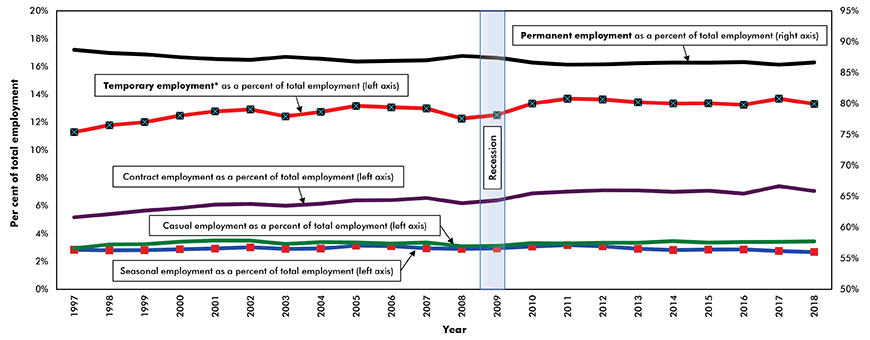Are we all destined to be part of the “gig” economy? Over the past few years an increasing number of commentators have predicted that “the online gig economy is growing, but no one knows by how much”. Others say “The gig economy is here and the transformation is happening at an astonishing speed”.
They claim that a scarcity of “real” jobs (i.e. permanent jobs with benefits) is forcing more workers in the U.S. and Canada to work as delivery couriers, as Uber drivers or to perform contract work. These jobs have no benefits and are contingent on a particular employer’s need that may evaporate at any time.
A recent article in the Wall Street Journal titled “How Estimates of the Gig Economy (in the U.S.) Went Wrong” relates how two economists who have done considerable research on the gig economy, Alan Krueger of Princeton University and Lawrence Katz of Harvard, overestimated its size.
Based on more current (2017) data, they have concluded that in the immediate aftermath of the recession, an increasing number of individuals moved into the “gig” economy and did “odd jobs” in order to pay their bills. However, as the economy picked up speed and labour demand strengthened, people returned to more traditional work arrangements. More definitive evidence of the overestimation of the number of gig workers was released in mid-2018 by the U.S. Bureau of Labor Statistics.
It reported that the share of workers employed as independent contractors, in short-term jobs or otherwise in alternative employment arrangements, was 6.9% in May of 2017 down from 7.4% in February of 2005 and about the same as it was in February of 1995. The same release reported that 3.8% of U.S. workers held contingent jobs in May of 2017, the smallest percentage since the Current Population Survey was initiated in 1995.
In Canada, there have been a number of articles which suggest that we are all about to become members of the gig economy. In an article titled “The future is temporary, what the gig economy means for you”, the staffing firm Workopolis concluded that, based on the fact part-time hiring exceeded full-time hiring by 27,000 in 2016, part-time hiring was accelerating in Canada.
However, as the chart illustrates, it appears that, as in the United States, the recession caused an increasing share of workers to seek refuge in the informal “gig” economy until they found a permanent job. Following the temporary hiatus in 2016, full-time hiring increased by 279,000 in 2017 almost five times the 57,000 rise in part-time hiring. This strong pattern of full-time hiring intensified in 2018 when it rose by 285,000 while the number of part-time employees shrank by 35,000.
Based on Stats Canada labour force data, the share of total employees working part time, currently 19%, has remained almost flat in the range of 17.9% to 20.3% since 1997.
There are a number of other statistics which reinforce the view that the future of work is not “temporary”. First, the percentage of the workforce categorized as self employed (i.e. working owners of incorporated or unincorporated businesses), currently at 15.1%, has remained in the range of 13.7% to 17.4% and exhibited no trend, up or down, for the past 29 years. Also, although the percentage of workers in permanent jobs is slightly lower now at 86.7% than it was in 1997 (88.7%), it has remained essentially unchanged for the past eight years.
Consistent with the slight decline in the share of workers in permanent employment, the percentage of workers in temporary jobs, which includes contract, seasonal and casual employment, is somewhat higher now at 13.3% than it was 20 years ago (11.3%).
However, since 2010 it has also exhibited little change. One final indicator that reinforces the view that the nature of work in Canada is not changing quickly is the duration of job tenure (i.e. the number of months that employees remain in the same job). It has trended steadily higher from 7.2 years in 1987 when Stats Canada started recording it to 8.5 years in 2018. Job tenure in the construction industry is shorter than other industries since workers are frequently hired to work on projects of limited duration. However, despite this structural constraint, job tenure in the industry currently averages 7.6 years compared to 5.8 years in 1976.
Going forward, a number of factors will gradually alter the future of work in Canada. First, an aging workforce that is, on average, living longer and healthier and wants to remain involved but doesn’t want a nine-to-five job, will have an increased appetite for temporary work. At the same time, employer’s facing a shrinking volume of 15 to 24 year olds entering the labour force will increasingly source new hires from the the 55+ age group. This trend should be reinforced by the fact that a significant proportion of “mature” workers have a pension and health benefits from their previous employer and they do not need all the hand holding of younger employee with limited work experience. In addition, having a grown up family gives these mature workers more flexibility in scheduling their time, while the internet gives them the ability to work remotely.
John Clinkard has over 35 years’ experience as an economist in international, national and regional research and analysis with leading financial institutions and media outlets in Canada.
Employment by Job Permanence

Chart: ConstructConnect — CanaData.











Recent Comments